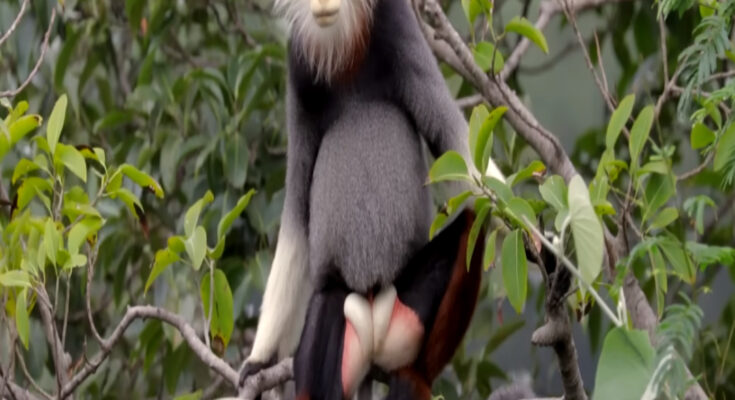Among the world’s most vibrant and captivating primates is the red-shanked douc langur, an endangered species known for its stunning appearance and intricate social behavior. Found primarily in the forests of Vietnam, Laos, and Cambodia, this monkey’s striking coloration and unique characteristics have earned it the title of one of the most colorful primates. This essay explores the red-shanked douc langur’s distinctive features, its habitat and behavior, the threats it faces, and the efforts being made to ensure its survival.
Distinctive Features
The red-shanked douc langur is a visual marvel in the primate world. Its name derives from the bright red coloration on its lower legs, which contrasts sharply with its blue-gray body, white forearms, and black hands and feet. The face of the douc langur is equally striking, with a golden-orange hue, expressive eyes framed by white eyelids, and a pronounced black border around the face. Adding to its allure, this primate has a long, white tail and a white tuft on the end, which enhances its majestic appearance.
The coloration of the red-shanked douc langur is not just for show; it plays a crucial role in social signaling and identification among troop members. These vivid colors help individuals recognize each other, facilitating social cohesion within their groups.
Habitat and Behavior
Red-shanked douc langurs inhabit the dense, tropical forests of Southeast Asia, where they primarily live in the upper canopy. They are arboreal and highly adept at navigating the treetops, using their strong limbs and long tails for balance and agility. Their diet consists mainly of leaves, fruits, flowers, and seeds, which they forage for in the forest canopy.
These monkeys are social animals, living in groups that can range from a few individuals to large troops of up to 50 members. Their social structure is complex, with clear hierarchies and strong bonds formed through grooming and other social interactions. Vocalizations, facial expressions, and body postures are used to communicate within the group, maintaining social order and coordination.
Threats to Survival
Despite their vibrant beauty and ecological importance, red-shanked douc langurs are facing numerous threats that have pushed them to the brink of extinction. Habitat destruction is the primary threat, as deforestation for agriculture, logging, and urban development rapidly diminishes their forest homes. The fragmentation of habitats isolates populations, reducing genetic diversity and making it harder for groups to find food and mates.
Hunting and poaching also pose significant threats. In some regions, these monkeys are hunted for their meat, traditional medicine, or the pet trade. The distinctive and beautiful fur of the douc langur makes it a target for the illegal wildlife trade, further endangering their populations.
Conservation Efforts
Conservationists and researchers are working tirelessly to protect the red-shanked douc langur from extinction. Efforts include the establishment of protected areas and national parks where these monkeys can live safely. Organizations are also working to enforce anti-poaching laws and combat illegal wildlife trade through stricter regulations and awareness campaigns.
Community-based conservation programs are essential in involving local communities in the protection of their natural heritage. By promoting sustainable land-use practices and providing alternative livelihoods, these programs help reduce the pressures on forest resources and encourage coexistence with wildlife.
Education and awareness initiatives are crucial in changing public attitudes towards these primates. By highlighting the ecological and cultural significance of the red-shanked douc langur, conservationists aim to foster a sense of pride and responsibility in local populations, ensuring long-term conservation success.
Conclusion
The red-shanked douc langur is a testament to the incredible diversity and beauty of the primate world. Its vibrant colors and complex social behavior make it one of the most fascinating and visually stunning monkeys. However, the survival of this species is threatened by habitat destruction, hunting, and the illegal wildlife trade. Through concerted conservation efforts, there is hope that the red-shanked douc langur can be protected and preserved for future generations. By understanding and valuing these magnificent primates, we take a crucial step towards safeguarding the rich biodiversity of our planet.



